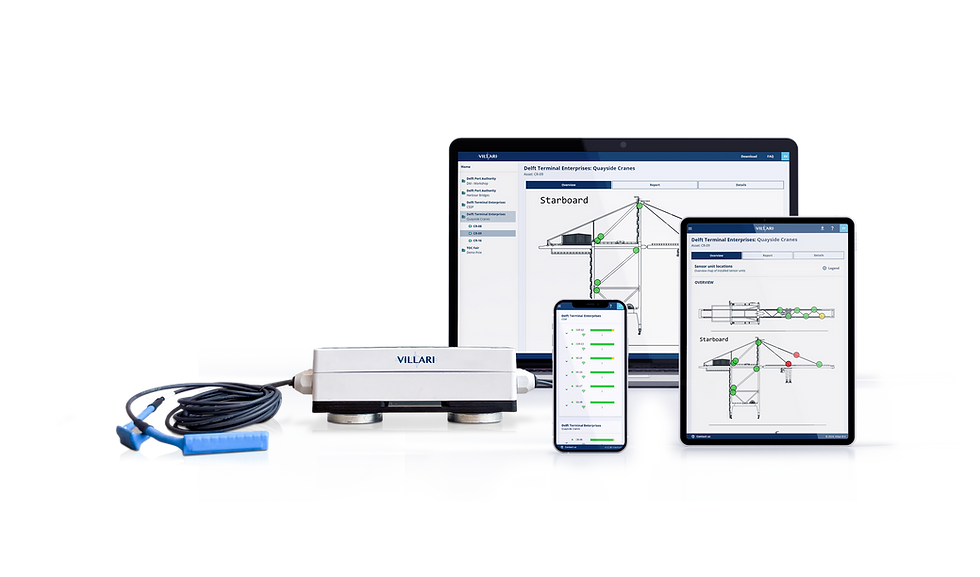Why periodic NDT alone is failing critical infrastructure
- Andrea Farkas
- Sep 9
- 3 min read
Updated: Sep 25
NDT isn’t going away but it can’t do the job alone anymore

Smooth operations are a must to stay in business. You want to be reliable for your customers and partners.
Many businesses, ranging from port to heavy industrial manufacturing to infrastructure rely on periodic, often schedule based visual checks and NTD to assess the structural integrity of the steel structure. Despite the regular checks, incidents happen.
Unplanned downtime interrupts operations, which can result in revenue loss and may also lead to challenges related to reputation and reliability.
You may rush into extensive repairs or even full replacements, requiring substantial CAPEX investment because you rather want to be safe than sorry.
Does this sound familiar?
But before diving into alternatives, let’s start with what NDT is all about.
Non-destructive testing (NDT) has long been the industry standard for inspecting steel infrastructure from cranes and bridges to industrial machinery and offshore platforms. These periodic inspections, often scheduled every 6 to 36 months, aim to detect fatigue, cracks, and damage before failure occurs. But as infrastructures age, loads vary and increase, and the demand for uptime grows, one thing is becoming clear:
Periodic NDT alone is no longer enough to protect critical assets.
Here’s why it’s falling short and what operators are doing to stay ahead.
1. Cracks don’t wait for inspection windows
The biggest flaw of periodic NDT is simple: cracks can form and grow between inspections, often with no visual cues. When a weld or structure is only tested once a year, there’s a 364-day blind spot where stress, fatigue, or vibration may be quietly accelerating crack growth.Crack propagation is not linear or predictable. In some cases, a stable crack can suddenly become critical in a few days. This means timing, not just technique is key.
2. Visual & manual methods are resource-intensive
Even with skilled teams, traditional inspection methods are time-consuming and often disruptive:
Shutting down operations for access for days or even weeks in case of extensive checks
Scheduling rope access or confined space entry
Being unable to inspect due to unpredictable weather conditions
Relying on subjective judgment for crack assessment
In today’s world when we are also facing an increased degree of labor shortage, finding reliable and available personnel comes with its own challenges.
3. Surface inspections can miss what’s really beneath the surface
Most NDT methods are surface-based, therefore require specific surface preparation, and it can be complicated to get to the exact initiation location of the crack. But if you don’t know where to look, you won’t find it. Cracks often initiate in high-stress areas that are inaccessible, hidden behind plating, or located in complex welds. Even ultrasonic or magnetic particle testing have their limits when used blindly.
Structural Health Monitoring (SHM) closes the gaps
This is where continuous, data-driven structural monitoring is changing the game.
Structural Health Monitoring systems like Villari’s offer a fundamentally different approach:
Permanent wireless sensors are installed on critical stress points of the steel structure offering continuous insights on crack propagation over time
Crack growth is tracked in real time, not retrospectively
It’s a cost-effective method over just simply increasing the number of inspections, especially in case of aging assets
Alerts trigger when thresholds are exceeded, allowing early and more accurate actions on what to repair and when without the need to make rushed repair decisions
Labor friendly alternative thanks to the remote monitoring option
This means maintenance is no longer a guess game. It’s data-driven, proactive, and continuous.
The below table summarizes the key differences between visual inspection, NTD methods and continuous SHM.
Feature | Visual Inspection | Phased Array Ultrasonic Testing | Magnetic Particle Inspection | Dye Penetrant | Villari Wireless Crack Detection | |
|---|---|---|---|---|---|---|
Detects surface flaws |  |  |  |  |  | |
Detects sub-surface cracks |  |  |  |  |  | |
Works on steel |  |  |  |  |  | |
Possible without surface preparation |  |  |  |  |  | |
Portable |  |  |  |  |  | |
Automation possible |  |  |  |  |  | |
Real-time visibility |  |  |  |  |  | |
Cost-effective solution |  |  |  |  |  | |
Limitations | Subjective | Skilled use / subjective | Messy / surface-only | Surface-only | It's for steel only and requires sensor planning | |
Leverging Structural Health Monitoring, operators can make confident repair, inspection and investment choices. Receiving real-time continuous insights enables you to:
Avoid unplanned downtime and shutdowns
Delay non-critical repairs and phase them strategically
Push out major CapEx confidently
Increase safety and reduce operational and reputational risks
Reduce environmental impact
In summary
Periodic NDT is still playing an important role in assessing asset integrity and can provide valuable insights when used at the right time and place. But today and beyond, it’s not enough on its own. Operators need real-time data.They need confidence.They need to know what’s happening between inspections.
That’s where SHM comes in.
Want to learn how continuous crack monitoring is being deployed on real assets?
Get in touch with our team



Comments